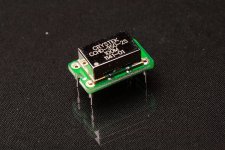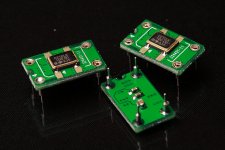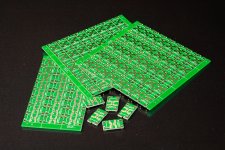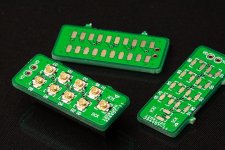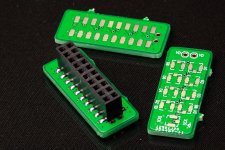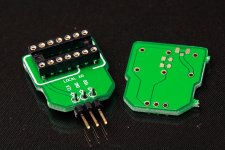excellent! these will also with a bit of lead bending work with my USB interface.
karvid, no I dont think they will be all that useful for BII, i'm sure you could find something to do with it, but it wont plug right in like it does with BIII well actually it looks like it could be bent to the task, Ian can explain that, the ufl header looks to be designed to suit the BIII input header though
what do you mean you dont know what signal you get out of the fifo? i2s + clock … its an i2s buffer/master clock. its a pretty specific device with only one main purpose. it has spdif input and output too if you buy that part of course.
its great that word of this device is getting out around the place, perhaps some people are just buying it because people are saying its the best thing to do, without actually knowing how it works? maybe you should put the manual in the front page Ian?
karvid, no I dont think they will be all that useful for BII, i'm sure you could find something to do with it, but it wont plug right in like it does with BIII well actually it looks like it could be bent to the task, Ian can explain that, the ufl header looks to be designed to suit the BIII input header though
what do you mean you dont know what signal you get out of the fifo? i2s + clock … its an i2s buffer/master clock. its a pretty specific device with only one main purpose. it has spdif input and output too if you buy that part of course.
its great that word of this device is getting out around the place, perhaps some people are just buying it because people are saying its the best thing to do, without actually knowing how it works? maybe you should put the manual in the front page Ian?
Last edited:
its a conversion board system, there are 2 parts,
1. it allows the clock from the BIII and probably BII to be removed and this adapter connected in its place, then it has a u.fl connector header on it (mini bnc) which allows proper connection on an external master clock signal to be connected from the fifo clock board output so that you can run a synchronous clock, running the dac from the very same clock as the fifo.
it also appears to have a place to connect a clock in a socket on top to allow you to easily switch between synchronous and asynchronous clocking. I would say you can probably use this with BII, maybe not as neatlyI havent studied it closely, I dont use BIII or BII with fifo, i'm running an ackodac
2. the second part converts the multichannel i2s header on BIII to multiple u.fl headers for the rest of the i2s inputs for BCK, WCK, SDATA (BCK, D1, D2) for better impedance controlled and neat connections, pinheaders really arent ideal for i2s and the fifo has u.fl for better signal integrity
1. it allows the clock from the BIII and probably BII to be removed and this adapter connected in its place, then it has a u.fl connector header on it (mini bnc) which allows proper connection on an external master clock signal to be connected from the fifo clock board output so that you can run a synchronous clock, running the dac from the very same clock as the fifo.
it also appears to have a place to connect a clock in a socket on top to allow you to easily switch between synchronous and asynchronous clocking. I would say you can probably use this with BII, maybe not as neatlyI havent studied it closely, I dont use BIII or BII with fifo, i'm running an ackodac
2. the second part converts the multichannel i2s header on BIII to multiple u.fl headers for the rest of the i2s inputs for BCK, WCK, SDATA (BCK, D1, D2) for better impedance controlled and neat connections, pinheaders really arent ideal for i2s and the fifo has u.fl for better signal integrity
Last edited:
Got those adapter PCBs today finally! I made right decision, re-ordering the PCB immediately after found lost. The DHL investigating still under going, I don't think they could find anything.
I'll do some test and let you know the result tomorrow.
Have a good night
Ian
Ian,
shall we sign up for these boards and the u.fl adapters right here in this thread ?
cheers,
Pepe
Ian,
shall we sign up for these boards and the u.fl adapters right here in this thread ?
cheers,
Pepe
I'll list them together with GB II details, hopefully this weekend. You just need update your order after that. I have enough PCB to supply this time.
Ian
New universal SMT XO adapter tested
New universal SMT XO adapter is compatible with most popular SMT XOs, CCHD957,CCHD950, 7*5, 5*3.2,3.2*2.5,2.5*2(NZ2520S)... The decoupling capacitors at back are optional. Two 100n 0603 and one 1u 0805 are recommended. But if the XO has good internal decoupling capacitors, then you don’t need any of them.
I did some test on a couple of different size XOs yesterday, CCHD950, NZ2520S and a normal 7*5 XO. They woke well. See the pictures for details.
The manufacturer combined 40 of them in one piece of PCB with v-cut. I don’t like the rough edge. You have to use file or sand paper to make it looks nicer before assemble. It seems I have enough PCB to supply this time. One FIFO KIT still comes with one adapter kit for free. I’ll list it with the GB II details for those who need more.
Ian
New universal SMT XO adapter is compatible with most popular SMT XOs, CCHD957,CCHD950, 7*5, 5*3.2,3.2*2.5,2.5*2(NZ2520S)... The decoupling capacitors at back are optional. Two 100n 0603 and one 1u 0805 are recommended. But if the XO has good internal decoupling capacitors, then you don’t need any of them.
I did some test on a couple of different size XOs yesterday, CCHD950, NZ2520S and a normal 7*5 XO. They woke well. See the pictures for details.
The manufacturer combined 40 of them in one piece of PCB with v-cut. I don’t like the rough edge. You have to use file or sand paper to make it looks nicer before assemble. It seems I have enough PCB to supply this time. One FIFO KIT still comes with one adapter kit for free. I’ll list it with the GB II details for those who need more.
Ian
Attachments
Last edited:
U.FL input adapter and Sync-Async clock adapter for BIII
I like both of them. They were integrated into one PCB, but it's separable. I'll do some test on my BIII and will let you know the result on the technical thread http://www.diyaudio.com/forums/digi...-project-ultimate-weapon-fight-jitter-75.html later on.
Have a good night.
Ian
I like both of them. They were integrated into one PCB, but it's separable. I'll do some test on my BIII and will let you know the result on the technical thread http://www.diyaudio.com/forums/digi...-project-ultimate-weapon-fight-jitter-75.html later on.
Have a good night.
Ian
Attachments
Ian, they look perfect!
I had not seen those 2 x 10pin headers with the surface mount connections previously, only through hole versions, they've really allowed you to achieve the most compact and optimal arrangement! I tried to work out an arrangement earlier in the year with a through hole pin header part and didn't ever get to an arrangement I was happy with.
Almost makes me wish I had a BIII!
I had not seen those 2 x 10pin headers with the surface mount connections previously, only through hole versions, they've really allowed you to achieve the most compact and optimal arrangement! I tried to work out an arrangement earlier in the year with a through hole pin header part and didn't ever get to an arrangement I was happy with.
Almost makes me wish I had a BIII!
Ian, they look perfect!
I had not seen those 2 x 10pin headers with the surface mount connections previously, only through hole versions, they've really allowed you to achieve the most compact and optimal arrangement! I tried to work out an arrangement earlier in the year with a through hole pin header part and didn't ever get to an arrangement I was happy with.
Almost makes me wish I had a BIII!
Yes, that's exactly the reason I like them. It's kind of perfect solution, even better then I thought.
I don't have a BII, so I don't know if there is any possible to revise for BII?
Good luck,
Ian
Ahhh you see I actually don't have a BII either. I have a TP Opus at the moment and plans to probably get a ackodac at some point but my DAC building is on back burner at the moment, was told by the 'boss' to finish some other projects before I do any new ones.
Cheers,
Chris
Cheers,
Chris
Bitrate shaping
Ian, I take the time now to post something I should have done long ago. I once was part of an R&D project for asynchronous transfer mode communication. The problem we faced was extreme burstiness of the sender (e.g. TV frames). One research fellow from London had the idea of bit rate shaping: by using two buckets with just a shallow bit depth he showed it was possible to accommodate for most burtiness such that the output was near to constant bit rate. Since that time large routers (I remember from Cisco) have a double buffer at the receiving side.
I know you have a big buffer to accommodate for fluctuations. However, it would be fun if this idea of two series buffers would help you.
I hope I'm not completely off track.
albert
Ian, I take the time now to post something I should have done long ago. I once was part of an R&D project for asynchronous transfer mode communication. The problem we faced was extreme burstiness of the sender (e.g. TV frames). One research fellow from London had the idea of bit rate shaping: by using two buckets with just a shallow bit depth he showed it was possible to accommodate for most burtiness such that the output was near to constant bit rate. Since that time large routers (I remember from Cisco) have a double buffer at the receiving side.
I know you have a big buffer to accommodate for fluctuations. However, it would be fun if this idea of two series buffers would help you.
I hope I'm not completely off track.
albert
Hi Ian
Regarding Buffalo III adapter boards...
I'm not sure if You are planing to ship them already fully assembled with u.fl conectors and 2 x 10pin headers..as I can see at Your pictures.
I thing that for Buffalo II owners could be better to have just u.fl sockets and free access to confection pads on the other side of PCB.
Actually just clean PCB and not mounted u.fl conectors that would be OK with me.. There should be some "DIY-handmade" way to connect it to "ancient" BuffaloII 😎 ...
Well actually it seems to be perfect!!! for my Duall Mono I2S wiring set-up..😀
Best Regards
Rosendorfer
Regarding Buffalo III adapter boards...
I'm not sure if You are planing to ship them already fully assembled with u.fl conectors and 2 x 10pin headers..as I can see at Your pictures.
I thing that for Buffalo II owners could be better to have just u.fl sockets and free access to confection pads on the other side of PCB.
Actually just clean PCB and not mounted u.fl conectors that would be OK with me.. There should be some "DIY-handmade" way to connect it to "ancient" BuffaloII 😎 ...
Well actually it seems to be perfect!!! for my Duall Mono I2S wiring set-up..😀
Best Regards
Rosendorfer
Ian, I take the time now to post something I should have done long ago. I once was part of an R&D project for asynchronous transfer mode communication. The problem we faced was extreme burstiness of the sender (e.g. TV frames). One research fellow from London had the idea of bit rate shaping: by using two buckets with just a shallow bit depth he showed it was possible to accommodate for most burtiness such that the output was near to constant bit rate. Since that time large routers (I remember from Cisco) have a double buffer at the receiving side.
I know you have a big buffer to accommodate for fluctuations. However, it would be fun if this idea of two series buffers would help you.
I hope I'm not completely off track.
albert
Hi Albert,
Thank you for shareing you idea. It's an interesting method. I'm figuring out the multichannel FIFO now which will need more buffer memory. I'm interested in using smaller memory. Your idea might be help.
I appreciate your experience. Have a nice weekend.
Ian
Hi Ian
Regarding Buffalo III adapter boards...
I'm not sure if You are planing to ship them already fully assembled with u.fl conectors and 2 x 10pin headers..as I can see at Your pictures.
I thing that for Buffalo II owners could be better to have just u.fl sockets and free access to confection pads on the other side of PCB.
Actually just clean PCB and not mounted u.fl conectors that would be OK with me.. There should be some "DIY-handmade" way to connect it to "ancient" BuffaloII 😎 ...
Well actually it seems to be perfect!!! for my Duall Mono I2S wiring set-up..😀
Best Regards
Rosendorfer
Soldering those U.FL sockets is not an easy job. I would be more than happy to supply the bare PCB only. 😀
Ian
they really arent that hard, Ian is exaggerating it, or he is too used to having excellent tools or reflow =) w.fl are a bit harder (about 3-4x smaller again) but still totally doable
Hi guys
Im waiting for XMOS based converter from Lorien and have few questions regarding FIFO device.
1. Would it be still improvement to add FIFo to chain together with XMOS converter or converter should make its job alone with great results?
2. I use Spencer DAC now with I2S connection but I have plans for AD1865 DAC with SPDiF outputs only and receiver would be WM8804. Spencer uses CS8416 receiver. I assume in such case its better to use Ian SPDiF device for both DACs. Do I loose a lot in SPDiF connection vs I2S or its not that obvious when digital section is well implemented?
3. Is it worth buying dual XO board? What are benefits? Anyone tested?
I still search best solution from PC sound so if anyone tested mentioned above I would appreciate it🙂
Thanks
Im waiting for XMOS based converter from Lorien and have few questions regarding FIFO device.
1. Would it be still improvement to add FIFo to chain together with XMOS converter or converter should make its job alone with great results?
2. I use Spencer DAC now with I2S connection but I have plans for AD1865 DAC with SPDiF outputs only and receiver would be WM8804. Spencer uses CS8416 receiver. I assume in such case its better to use Ian SPDiF device for both DACs. Do I loose a lot in SPDiF connection vs I2S or its not that obvious when digital section is well implemented?
3. Is it worth buying dual XO board? What are benefits? Anyone tested?
I still search best solution from PC sound so if anyone tested mentioned above I would appreciate it🙂
Thanks
Hi guys
Im waiting for XMOS based converter from Lorien and have few questions regarding FIFO device.
--------I have one of these.
1. Would it be still improvement to add FIFo to chain together with XMOS converter or converter should make its job alone with great results?
--------I have these on order, so when Ian is ready I will hope to be as well. I would use the WaveIO isolated outputs into the FIFO then to dac, one less conversion. I'm pretty sure Ian has allowed for your dac in upcoming firmware. Check previous posts for this info.
2. I use Spencer DAC now with I2S connection but I have plans for AD1865 DAC with SPDiF outputs only and receiver would be WM8804. Spencer uses CS8416 receiver. I assume in such case its better to use Ian SPDiF device for both DACs. Do I loose a lot in SPDiF connection vs I2S or its not that obvious when digital section is well implemented?
--------I2S requires impedance matching on the transmission lines to the dac, if not done correctly it will smear and affect the waveform with reflections, google Steve Nugent/empirical audio and you will learn much. if the i2s is done correctly you are much better off. There will be others here that know much more than me.
3. Is it worth buying dual XO board? What are benefits? Anyone tested?
--------Dual XO board allows for all sample rate multiples of 44.1 and 48kHz. If you listen to anything other than 44.1, you will need the Dual XO.
I still search best solution from PC sound so if anyone tested mentioned above I would appreciate it🙂
--------I have the Wave on a Alix 2D2>waveIO>fifo(soon)>Buff III>tube I/v(soon). I run mpdpup on the Alix which is easy to install and tweaks are forthcoming, you can read up here.
Puppy Linux Discussion Forum :: View topic - mpdPup - Simplified MPD Music Server/Jukebox - v0.9.2
Thanks
- Home
- Group Buys
- Ian asynchronous I2S and S/PDIF FIFO KIT group buy
